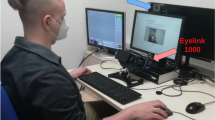Abstract
After their introduction by Robinson (IEEE Trans Biomed Eng 10:137–145, 1963), magnetic scleral search coils quickly became an accepted standard for precise eye movement recordings. While other techniques such as video-oculography or electro-oculography may be more suitable for routine applications, search coils still provide the best low-noise and low-drift characteristics paired with the highest temporal and spatial resolution. The problem with search coils is that many research laboratories still have their large and expensive coil systems installed and are acquiring eye movement data with old, analog technology. Typically, the number of recording channels is limited and modifications to an existing search coil system can be difficult. We propose a system that allows to retro-fit an existing analog search coil system to become a digital recording system. The system includes digital data acquisition boards and a reference coil as the hardware part, receiver software, and a new calibration method. The circuit design has been kept simple and robust, and the proposed software calibration allows the calibration of a single coil within a few seconds.






Similar content being viewed by others
References
Agrawal Y, Schubert MC, Migliaccio AA, Zee DS, Schneider E, Lehnen N, Carey JP (2014) Evaluation of quantitative head impulse testing using search coils versus video-oculography in older individuals. Otol Neurotol 35(2):283–288. doi:10.1097/MAO.0b013e3182995227
Bankman IN, Thakor NV (1990) Noise reduction in biological step signals: application to saccadic EOG. Med Biol Eng Comput 28:544–549
Bartl K, Siebold C, Glasauer S, Helmchen C, Buettner U (1996) A simplified calibration method for three dimensional eye movement recordings using search coils. Vision Res 36:997–1006
Bergamin O, Zee DS, Roberts DC, Landau K, Lasker AG, Straumann D (2001) Three-dimensional hess screen test with binocular dual search coils in a three-field magnetic system. Invest Ophthalmol Vis Sci 42:660–667
Chim D, Lasker DM, Migliaccio AA (2013) Visual contribution to the high-frequency human angular vestibulo-ocular reflex. Exp Brain Res 230(1):127–135. doi:10.1007/s00221-013-3635-9
Collewijn H (1977) Eye- and head movements in freely moving rabbits. J Physiol 266:471–498
Collewijn H (2001) Interocular timing differences in the horizontal components of human saccades. Vision Res 41:3413–3423
Collewijn H, van der Mark F, Jansen TC (1975) Precise recording of human eye movements. Vision Res 15:447–450
Collewijn H, Van der Steen J, Ferman L, Jansen TC (1985) Human ocular counterroll: assessment of static and dynamic properties from electromagnetic scleral coil recordings. Exp Brain Res 59:185–196
Dits J, Houben MM, van der Steen J (2013) Three dimensional vestibular ocular reflex testing using a six degrees of freedom motion platform. J Vis Exp (75):e4144. doi:10.3791/4144
Goumans J, Houben MM, Dits J, van der Steen J (2010) Peaks and troughs of three-dimensional vestibulo-ocular reflex in humans. J Assoc Res Otolaryngol 11:383–393
Halmagyi GM, Curthoys IS (1988) A clinical sign of canal paresis. Arch Neurol 45:737–739
Haslwanter T, Clarke AH (2010) Eye movement measurement: electro-oculography and video-oculography. Vertigo Imbalance Clin Neurophysiol Vestib Syst 61:79
Haslwanter T, Ong J (2009) Applying knowledge—challenges in bringing scientific advances to dizzy patients. Ann NY Acad Sci 1164:309–315
Hess BJ (1990) Dual-search coil for measuring 3-dimensional eye movements in experimental animals. Vision Res 30:597–602
Houben MM, Goumans J, van der Steen J (2006) Recording three-dimensional eye movements: scleral search coils versus video oculography. Invest Ophthalmol Vis Sci 47:179–187
Hsieh CW, Kan CW, Jong TL (2007) Analysis of closed eyes motion using a wireless eye-mask. Med Biol Eng Comput 45:365–374
Iijima A, Minamitani H, Ishikawa N (2001) Image analysis of quick phase eye movements in nystagmus with high-speed video system. Med Biol Eng Comput 39:2–7
Job HM, Keating D, Evans AL, Parks S (1999) Three-dimensional electromagnetic model of the human eye: advances towards the optimisation of electroretinographic signal detection. Med Biol Eng Comput 37:710–719
Juhola M, Pyykko I (1987) Effect of sampling frequencies on the velocity of slow and fast phases of nystagmus. Int J Biomed Comput 20:253–263
Kimmel DL, Mammo D, Newsome WT (2012) Tracking the eye non-invasively: simultaneous comparison of the scleral search coil and optical tracking techniques in the macaque monkey. Front Behav Neurosci 6:49
Migliaccio AA, Schubert MC (2013) Unilateral adaptation of the human angular vestibulo-ocular reflex. J Assoc Res Otolaryngol 14:29–36
Moore ST, Haslwanter T, Curthoys IS, Smith ST (1994) Measurement of three dimensional eye position using image processing: a geometric approach. In: Proceedings of the IEEE—international conference on image processing, vol 1, pp 436–440
Reulen JP, Marcus JT, Koops D, de Vries FR, Tiesinga G, Boshuizen K, Bos JE (1988) Precise recording of eye movement: the IRIS technique. Part 1 Med Biol Eng Comput 26:20–26
Roberts D, Shelhamer M, Wong A (2008) A new “wireless” search-coil system. In: Proceedings of the 2008 symposium on eye tracking research applications (ETRA 08), pp197–204
Robinson DA (1963) A method of measuring eye movement using a scleral search coil in a magnetic field. IEEE Trans Biomed Eng 10:137–145
Schneider RM, Thurtell MJ, Eisele S, Lincoff N, Bala E, Leigh RJ (2013) Neurological basis for eye movements of the blind. PLoS ONE 8:e56556
Straumann D, Zee DS, Solomon D, Lasker AG, Roberts DC (1995) Transient torsion during and after saccades. Vision Res 35:3321–3334
van der Geest JN, Frens MA (2002) Recording eye movements with video-oculography and scleral search coils: a direct comparison of two methods. J Neurosci Methods 114:185–195
Acknowledgments
The authors would like to thank Adrian Lasker, Michael Schubert, Georgios Mantokoudis, Angela Wenzel, Geraldine Zúñiga, Marcela Davalos and Carolina Treviño Guajardo for their contribution during the measurements and the development of the system.
Author information
Authors and Affiliations
Corresponding author
Rights and permissions
About this article
Cite this article
Eibenberger, K., Eibenberger, B., Roberts, D.C. et al. A novel and inexpensive digital system for eye movement recordings using magnetic scleral search coils. Med Biol Eng Comput 54, 421–430 (2016). https://doi.org/10.1007/s11517-015-1326-3
Received:
Accepted:
Published:
Issue Date:
DOI: https://doi.org/10.1007/s11517-015-1326-3




